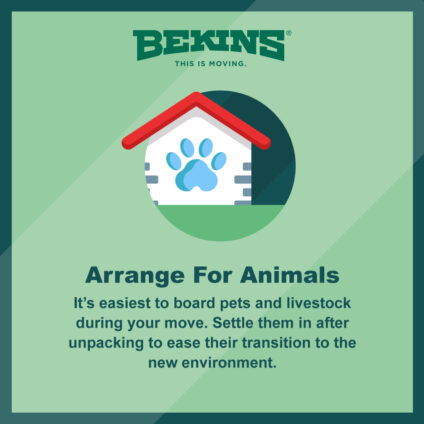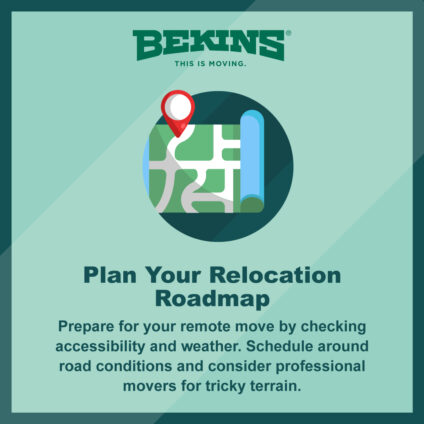 There are many reasons for wanting to leave the suburban or urban lifestyle. You might want to retire close to nature with ample chances for living off the land. Or maybe you want the challenge of living a greener lifestyle with minimal carbon impact. Perhaps you simply enjoy the isolation and resilience that can come from embracing simplicity.
There are many reasons for wanting to leave the suburban or urban lifestyle. You might want to retire close to nature with ample chances for living off the land. Or maybe you want the challenge of living a greener lifestyle with minimal carbon impact. Perhaps you simply enjoy the isolation and resilience that can come from embracing simplicity.
Whatever your reasons may be, preparing for a move from a more traditional home to a fully remote area can be a challenge in and of itself. You might not know where to begin when planning the move. That’s why the moving experts at Bekins have put together some guidelines to consider as you approach the big day.
Commit to Downsizing
Remote minimalist living involves simplifying your lifestyle and adapting to a smaller living space. This often means having limited storage, fewer appliances and reduced square footage compared to your current home. As you prepare to transition to a smaller or mobile home, consider these steps to effectively downsize:
-

Measure Your New Space: Before moving, accurately measure the rooms and storage areas in your new home to ensure your current furniture and appliances fit.
- Evaluate Your Furniture: Sell or donate items that are too large or bulky for your new home. This is particularly important if you’re moving into a mobile home, like a trailer or RV, where space is at a premium.
- Consolidate Appliances and Furniture: If you’re selling your current home, consider offering your appliances and bulky furniture as part of the home sale package.
- Prioritize Essential Items: Discard items typical of suburban or urban living that won’t be necessary in your new environment. For example:
- Replace a large set of fine china with more practical items like canning jars and tools for gardening and maintenance.
- Swap out a road bike used for commuting for one suited to rougher terrain.
- Utilize Temporary Storage: To avoid the stress of moving unnecessary items, rent a storage unit. Store items temporarily until you determine what you truly need in your new lifestyle.
- Reassess Stored Items: After living in your new home for a few months, revisit the items in storage. With a fresh perspective, decide what to keep based on their practicality and relevance to your new lifestyle.
Plan for the Essentials
Before your moving day, it’s crucial to ensure that your new home’s essentials are set up and functioning. Here are some key steps to prepare:
Secure Electricity Sources
Confirm that your electricity supply—whether it’s from the grid, generators or solar panels—is operational. That way you know you’ll have power ready when the moving truck arrives.
Arrange Water Supply
If your property does not have a water well, arrange to have your initial load of water delivered a day or two before you move in. This setup gives you immediate access to drinking water on moving day. If you do have a well, ensure the water is tested for potability before you move to guarantee it’s safe for consumption.
Fuel Supply Check
Verify the availability of fuel for heating and cooking. If you rely on a propane tank, contact the fuel provider to schedule a delivery before your move. Inform them of your moving date to coordinate the delivery efficiently and avoid any logistical issues with access roads.
Choose Your Moving Day and Route
Moving to a remote location presents unique logistical challenges that require careful planning and preparation. Here are steps to ensure a smooth transition to your new home:
- Assess Accessibility: Verify that the route to your new home is accessible for moving vehicles. It’s advisable to visit the site ahead of the moving truck to clear any potential obstructions like fallen trees or debris.
- Monitor Weather Conditions: Plan your move by analyzing weather patterns and selecting the best month for relocation. Aim for a day with favorable weather, as rain can lead to impassable muddy roads or unsafe driving conditions. Additionally, have a backup date in case of unexpected poor weather to avoid major disruptions to your plans.
- Do Some Route Research: Since country roads can be rough on your belongings, inquire with the local county office about the schedule for road maintenance. Try to coordinate your move with these activities to benefit from the best road conditions possible.
- Allow Sufficient Time: Give yourself plenty of time for the move to avoid feeling rushed. This is crucial when traveling on remote or challenging roads.
- Consider Professional Movers: If the access roads to your new home are particularly difficult, such as narrow mountain roads with sharp turns, it might be wise to hire professional movers. Look for a company experienced in navigating large vehicles in such conditions.
 Make Arrangements for Animals
Make Arrangements for Animals
If you own pets or livestock, consider boarding them until after your moving day. Managing the complexities of a move while simultaneously catering to the needs of animals can be overwhelming. Without the distraction of looking after animals, you can focus on settling into your new home.
Once you’ve had a few days to unpack and organize your space, you can then bring your animals to their new environment. This approach ensures that both you and your pets or livestock can adjust smoothly and stress-free.
Ready to Embrace Remote Living? Move With Bekins!

Moving to a remote area is a significant step, but it marks the exciting beginning of a more self-sufficient, minimalist lifestyle you may be seeking. To get started with your new adventure, contact Bekins Van Lines or request a free moving estimate.




